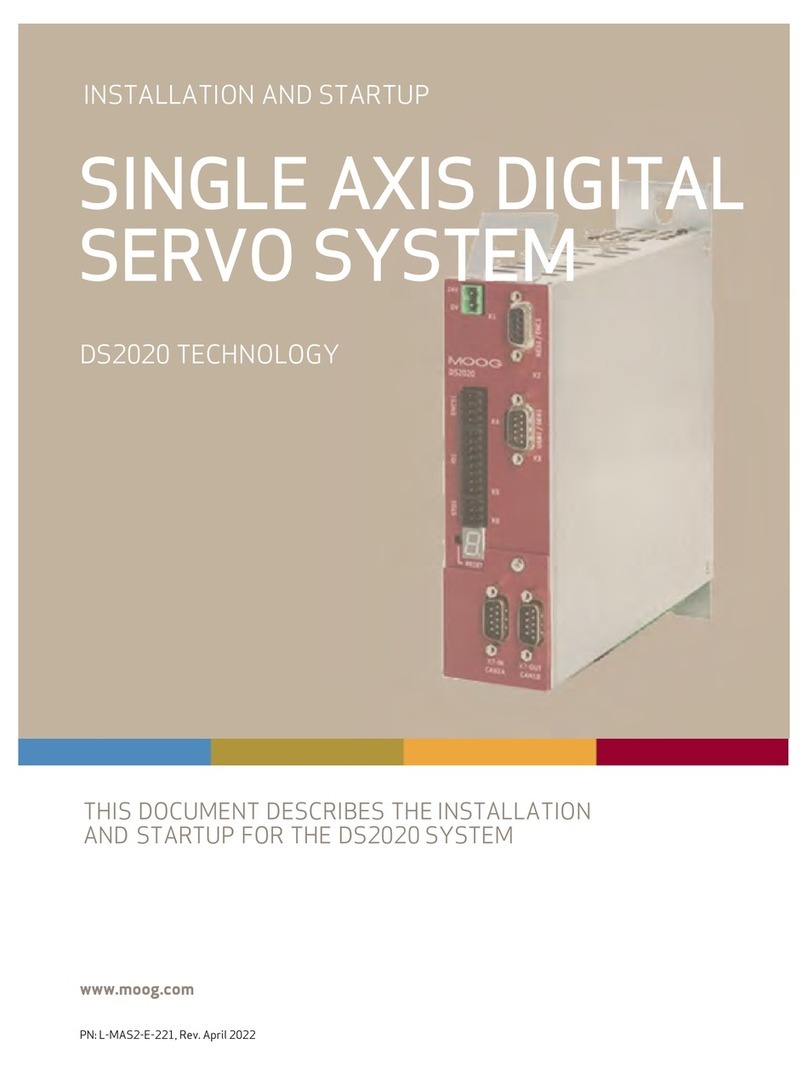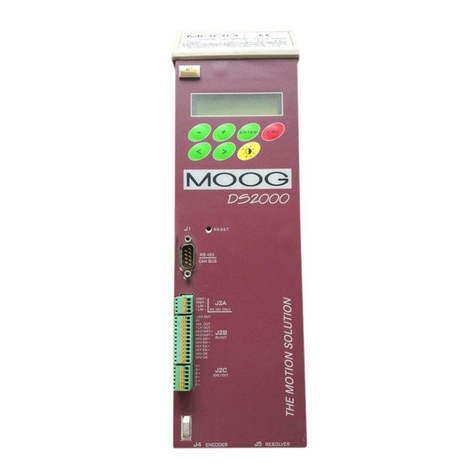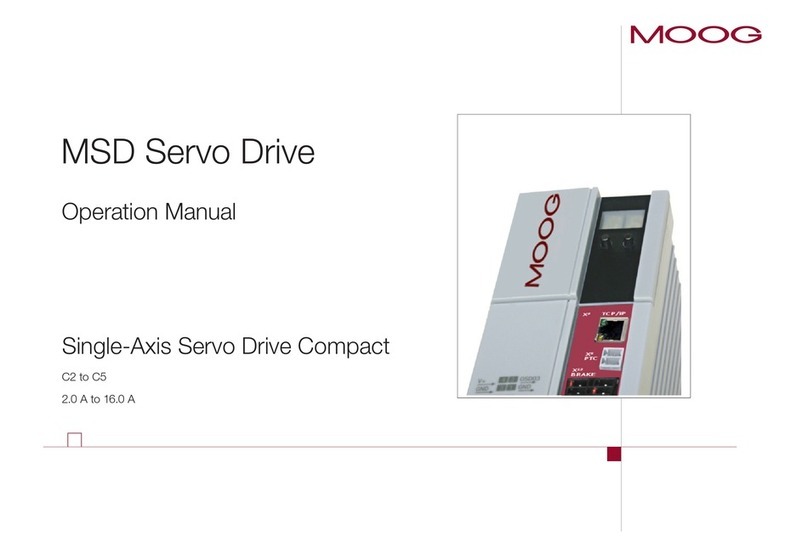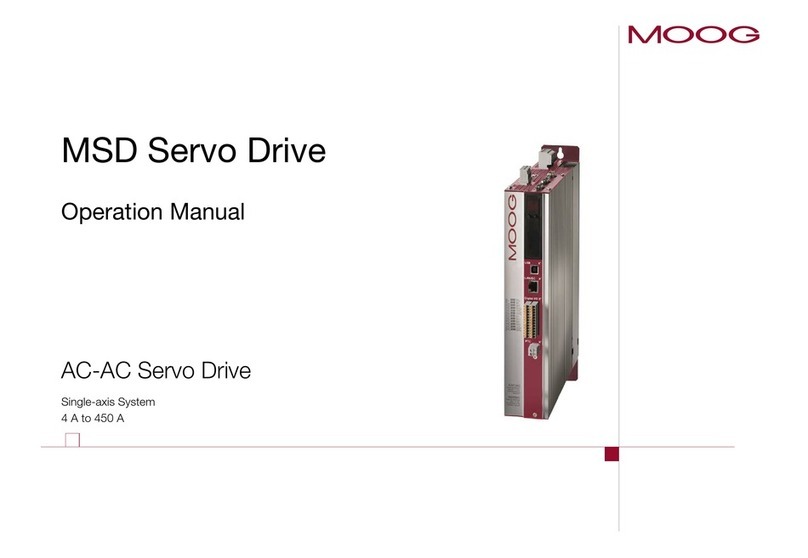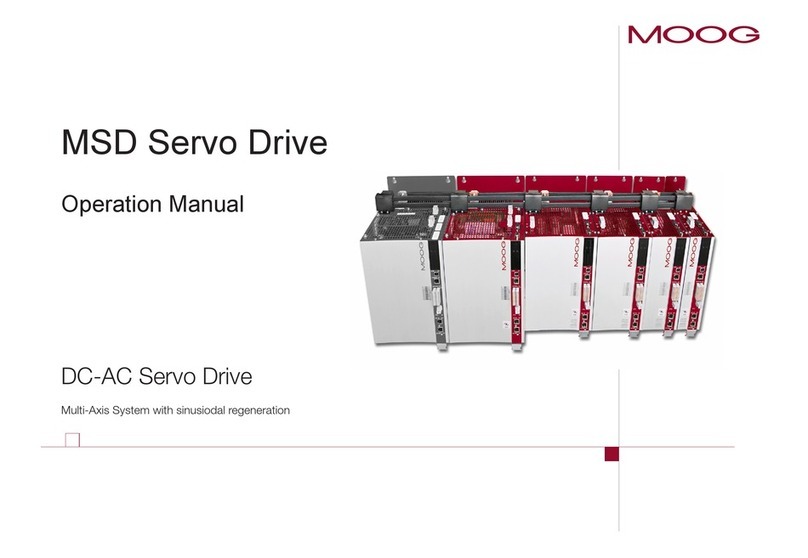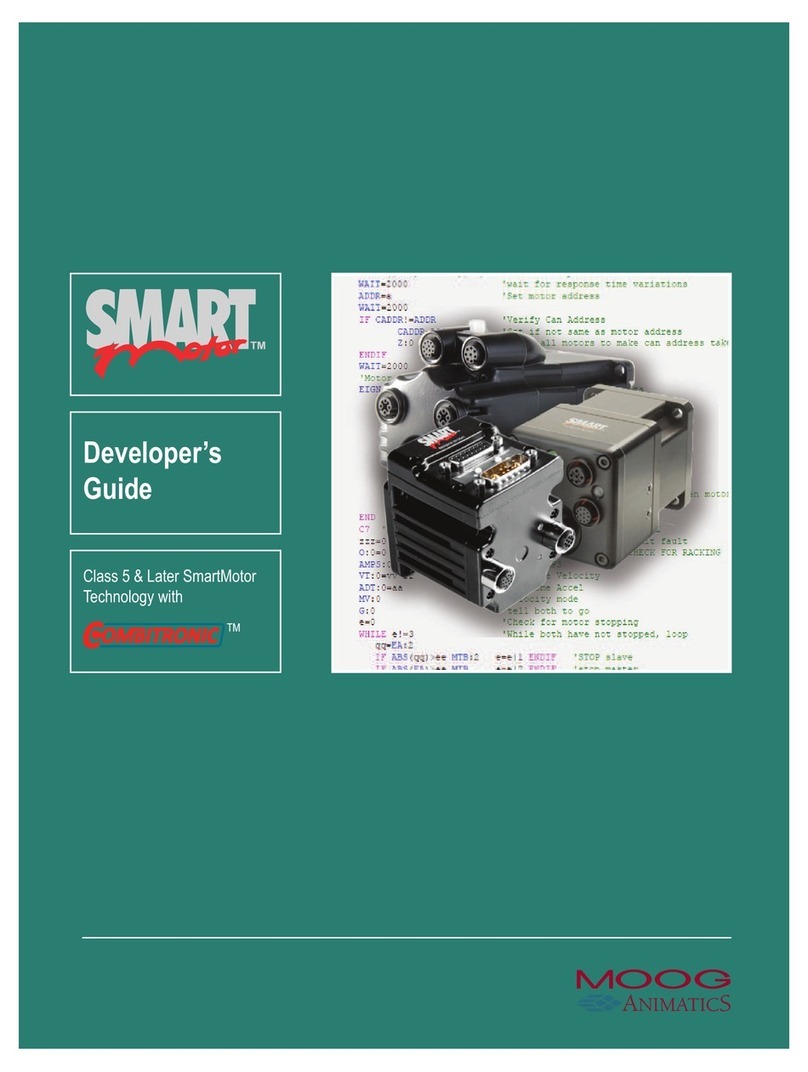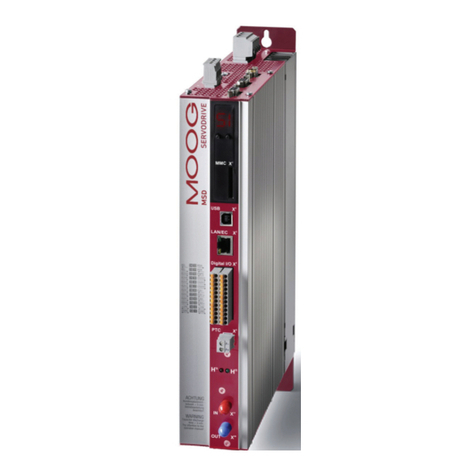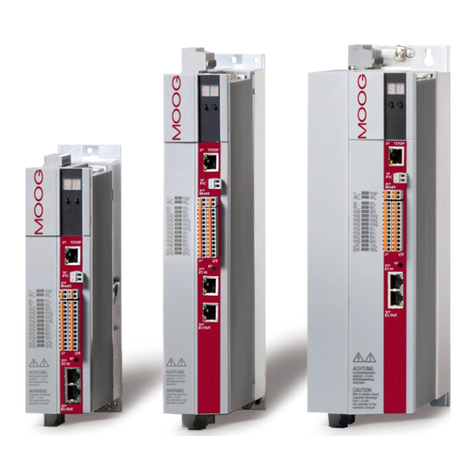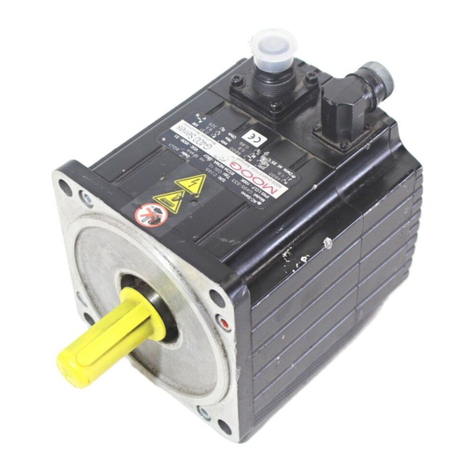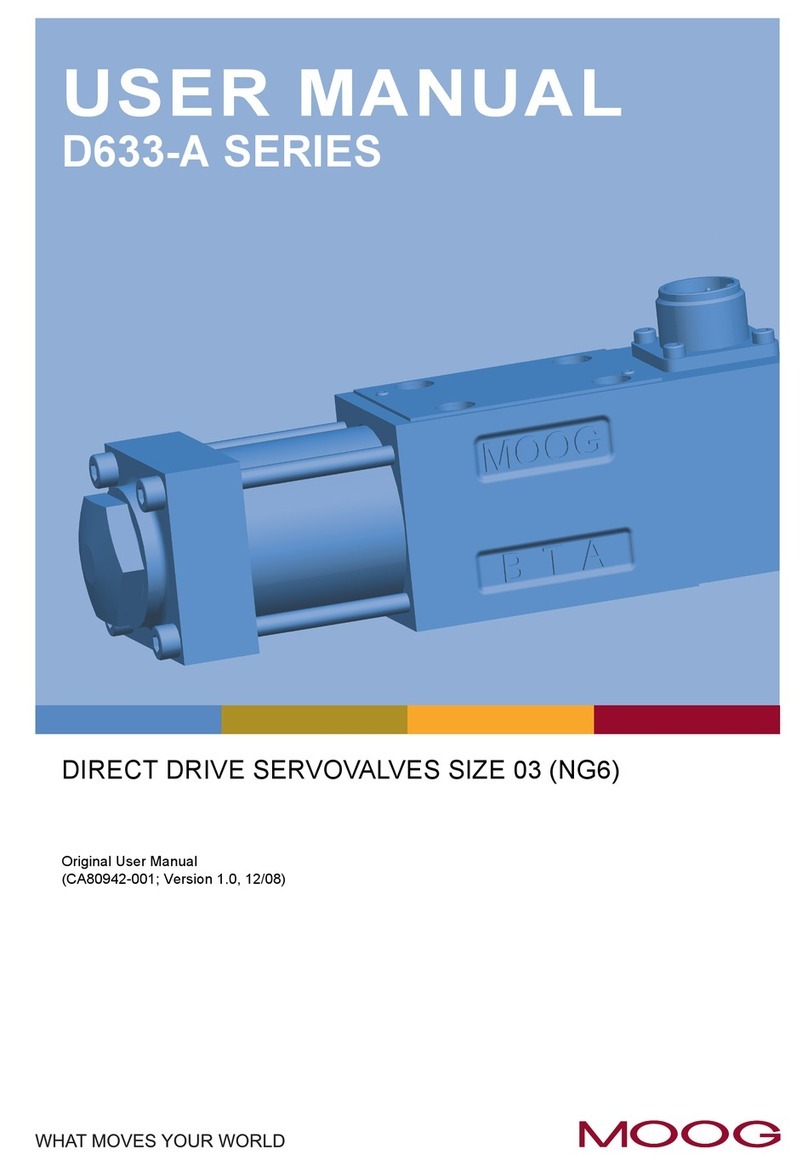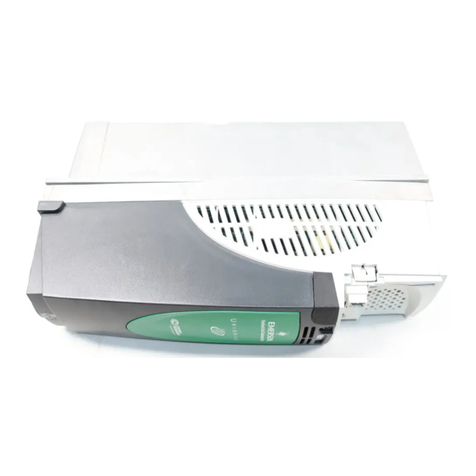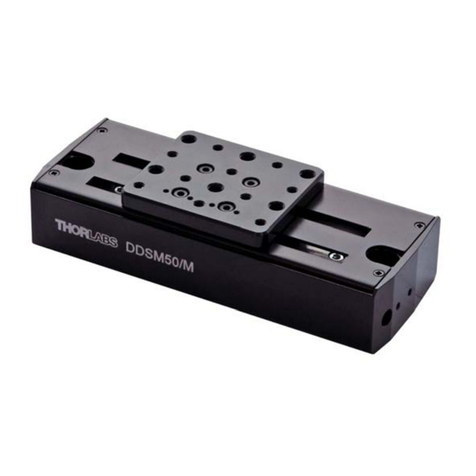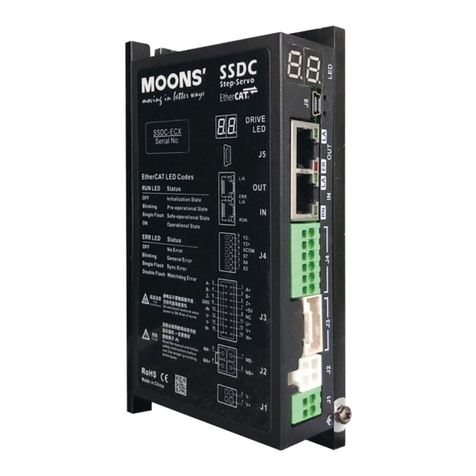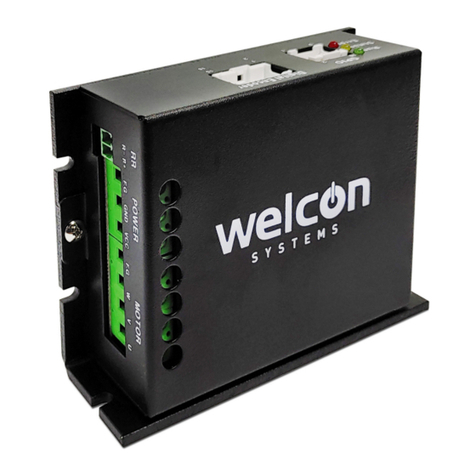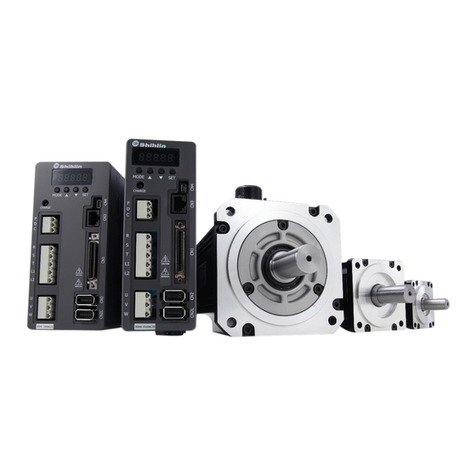Moog Class 5 SmartMotor User manual

Copyright Notice
©2014-2019, Moog Inc., Animatics.
Moog Animatics Class 5 SmartMotor™DMX Guide, Rev. C, PN: SC80100004-001.
This manual, as well as the software described in it, is furnished under license and may be
used or copied only in accordance with the terms of such license. The content of this manual is
furnished for informational use only, is subject to change without notice and should not be
construed as a commitment by Moog Inc., Animatics. Moog Inc., Animatics assumes no
responsibility or liability for any errors or inaccuracies that may appear herein.
Except as permitted by such license, no part of this publication may be reproduced, stored in a
retrieval system or transmitted, in any form or by any means, electronic, mechanical,
recording, or otherwise, without the prior written permission of Moog Inc., Animatics.
The programs and code samples in this manual are provided for example purposes only. It is
the user's responsibility to decide if a particular code sample or program applies to the
application being developed and to adjust the values to fit that application.
Moog Animatics and the Moog Animatics logo, SmartMotor and the SmartMotor logo,
Combitronic and the Combitronic logo are all trademarks of Moog Inc., Animatics.
Please let us know if you find any errors or omissions in this manual so that we can improve it
for future readers. Such notifications should contain the words "DMX Guide" in the subject line
and be sent by e-mail to: animatics_marcom@moog.com. Thank you in advance for your
contribution.
Contact Us:
Americas - West
Moog Animatics
2581 Leghorn Street
Mountain View, CA 94043
USA
Americas - East
Moog Animatics
750 West Sproul Road
Springfield, PA 19064
USA
Tel: 1 650-960-4215 Tel: 1 610-328-4000 x3999
Fax: 1 610-605-6216
Support: 1 (888) 356-0357
Website: www.animatics.com
Email: animatics_sales@moog.com

Moog Animatics Class 5 SmartMotor™ DMX Guide,Rev. C
Page 3 of 46
Table Of Contents
Introduction 5
Purpose 6
Combitronic Technology 6
DMX Overview 8
Safety Information 9
Safety Symbols 9
Other Safety Considerations 9
Motor Sizing 9
Environmental Considerations 9
Machine Safety 10
Documentation and Training 11
Additional Equipment and Considerations 11
Safety Information Resources 11
Additional Documents 13
Related Guides 13
Other Documents 13
Additional Resources 14
DMX Resources 14
Connections, Wiring and Status LEDs 15
Connectors and Pinouts 16
D-Style Motors: Connectors and Pinouts 16
M-Style Motors: Connectors and Pinouts 17
DMX NetworkTopology 17
System Cable Diagram 18
D-Style Multidrop Signal Cable Diagram 19
M-Style Multidrop Signal Cable Diagram 20
Understanding the Status LEDs 21
DMX on the SmartMotor 22
DMXImplementation 23
Data Storage and Usage 23
Example 24
Status Bits 25
End of Packet 25
DMXCommands 27

Moog Animatics Class 5 SmartMotor™ DMX Guide,Rev. C
Page 4 of 46
Select DMX Channels 27
Special Range Checking 28
Open DMX Channel 28
Close DMX Channel 28
Example Programs 29
Home Against a Hard Stop Example 30
Position Mode Control Example 32
DMX Five Channel Example 35
DMX Packet Test Example 38
Reverse DMXChannel Byte Order Example 40
Troubleshooting 43

Introduction
Moog Animatics Class 5 SmartMotor™ DMX Guide,Rev. C
Page 5 of 46
Introduction
This chapter provides an overview of the DMX features provided by the Moog Animatics
SmartMotor. It also provides information on safety, and where to find related documents and
additional resources.
Purpose 6
Combitronic Technology 6
DMX Overview 8
Safety Information 9
Safety Symbols 9
Other Safety Considerations 9
Motor Sizing 9
Environmental Considerations 9
Machine Safety 10
Documentation and Training 11
Additional Equipment and Considerations 11
Safety Information Resources 11
Additional Documents 13
Related Guides 13
Other Documents 13
Additional Resources 14
DMX Resources 14

Purpose
Moog Animatics Class 5 SmartMotor™ DMX Guide,Rev. C
Page 6 of 46
Purpose
This manual explains the Moog Animatics Class 5 SmartMotor™ support for the Digital
MultipleX (DMX) communications protocol. It describes the major concepts that must be
understood to integrate a SmartMotor as a DMX slave device. However, it only minimally
covers the low-level details of the DMX protocol.
NOTE: The Remote Device Management (RDM) bidirectional communication
extension of the DMX protocol is not supported.
The feature set described in this version of the manual refers to firmware in the 5.x.4.y
series, where x = 0, 16, 32, 97 or 98, and y=3 or greater. Versions 5.0.4, 5.16.4, and 5.32.4
are specific to D-style motors, and versions 5.97.4 and 5.98.4 are specific to M-style motors.
Refer to the following lists.
NOTE: The SmartMotor firmware must be one of the listed versions.
For D-style motors:
l5.0.4.y (where y is 3 or greater)
l5.16.4.y (where y is 3 or greater)
l5.32.4.y (where y is 3 or greater)
For M-style motors:
l5.97.4.y (where y is 3 or greater)
l5.98.4.y (where y is 3 or greater)
This manual is intended for programmers or system developers who have read and
understand the Engineering Commission of United States Institute for Theatre Technology
(USITT) DMX512-A standard. Therefore, this manual is not a tutorial on that standard or the
DMX protocol. Instead, it should be used to understand the specific implementation details for
the Moog Animatics Class 5 SmartMotor. Additionally, code examples are provided to assist
the programmer with the SmartMotor integration.
The Command Reference section of this manual includes details about the specific DMX
commands available in the SmartMotor through the DMX firmware. For details, see
DMXCommands on page 27.
Combitronic Technology
The most unique feature of the SmartMotor is its ability to communicate with other
SmartMotors and share resources using Moog Animatics’ Combitronic™ technology.
Combitronic is a protocol that operates over a standard CAN interface. It may coexist with
CANopen and other protocols. It requires no single dedicated master to operate. Each
SmartMotor connected to the same network communicates on an equal footing, sharing all
information, and therefore, sharing all processing resources.
While the Combitronic protocol can be used in parallel with a DMX network, there are certain
restrictions:
lThe DMX wiring does not carry the Combitronic signal. Therefore, additional cabling
(available from Moog Animatics) must be used to build the Combitronic network.

Combitronic Technology
Moog Animatics Class 5 SmartMotor™ DMX Guide,Rev. C
Page 7 of 46
lThere is bidirectional, end-to-end connectivity only within the same Combitronic
network of motors. Therefore, one Combitronic network cannot communicate with
another.
When a Combitronic network is used in parallel with a DMXnetwork, you can:
lAvoid the cost of repeaters.
lGain bidirectional, end-to-end connectivity within the Combitronic network of motors.
There are no other motors on the market that can talk to each other on a side bus while
being a slave to the DMX host controller.
lCompute or synchronize motion between motors within the same Combitronic network.
For example, DMX values (from the host controller) could be used to adjust amplitude
and frequency of SmartMotor Cam tables for an electronic camming or gearing
application that controls the motion pattern of a bank of stage lights.
In short, DMX-equipped SmartMotors retain all the features and benefits of the standard Class
5 SmartMotor, including features like electronic camming, gearing, and Combitronic support.
For additional details, see the Class 5 SmartMotor™ Installation & Startup Guide.

DMX Overview
Moog Animatics Class 5 SmartMotor™ DMX Guide,Rev. C
Page 8 of 46
DMX Overview
DMX is a standard for digital communications networks that are used to control lighting, stage
effects, dimmers, fog machines and related applications. This control may include positioning
and/or focusing of lights or other objects to aid in visual effects of stage productions or other
live events. As a result, its use is often expanded to the movement or control of curtains,
stage props or other objects that require motion.
DMX, or further expanded as DMX512, is an EIA-485 (RS-485) hardware-based protocol that is
unidirectional in nature — the controller only sends data; it does not receive data. Further, it
has no error checking or checksums that are required for use in hazardous applications.
Therefore, its use must be limited to safe operating environments where failure due to
transmission errors would not cause harm to personnel or equipment.
WARNING: DMX networks must not be used in applications where failure due
to transmission errors would cause harm to personnel or equipment.
DMX512 controllers transmit asynchronous serial data at 250 kilobaud (kBd). The data format
is fixed and begins with a single start bit, eight data bits, and two stop bits with no parity. Up
to 512 8-bit data bytes or "channels" of data may be transmitted to all nodes at once. The data
is ordered serially and typically runs continuously from a DMX master controller. The full data
packet begins with a break, followed by a Mark after Break (MAB), then Slot 0 beginning with
a one-byte Start Code, and that is followed by up to 512 data slots. Refer to the following
figure.
0 1 2 3 4 5 6 7 1 2
Start code and data channels
(11 bits, 4 μs each )
DATA BITS
STOP
BITS
START
BIT
IDLE
START
BREAK
100 μs
(could be as
low as 92 μs)
12
μs
MAB
Start Code in Slot 0
(followed by up to 512 data channels)
SLOT 0
44 μs
SLOT 1
44 μs
SLOT 2
44 μs
SLOT 3
44 μs
SLOT 4
44 μs
SLOT 5
44 μs
SLOT 6
44 μs
DMX Data Transmission

Safety Information
Moog Animatics Class 5 SmartMotor™ DMX Guide,Rev. C
Page 9 of 46
Safety Information
This section describes the safety symbols and other safety information.
Safety Symbols
The manual may use one or more of the following safety symbols:
WARNING: This symbol indicates a potentially nonlethal mechanical hazard,
where failure to follow the instructions could result in serious injury to the
operator or major damage to the equipment.
CAUTION: This symbol indicates a potentially minor hazard, where failure to
follow the instructions could result in slight injury to the operator or minor
damage to the equipment.
NOTE: Notes are used to emphasize non-safety concepts or related information.
Other Safety Considerations
The Moog Animatics SmartMotors are supplied as components that are intended for use in an
automated machine or system. As such, it is beyond the scope of this manual to attempt to
cover all the safety standards and considerations that are part of the overall machine/system
design and manufacturing safety. Therefore, the following information is intended to be used
only as a general guideline for the machine/system designer.
It is the responsibility of the machine/system designer to perform a thorough "Risk
Assessment" and to ensure that the machine/system and its safeguards comply with the
safety standards specified by the governing authority (for example, ISO, OSHA, UL, etc.) for
the locale where the machine is being installed and operated. For more details, see Machine
Safety on page 10.
Motor Sizing
It is the responsibility of the machine/system designer to select SmartMotors that are
properly sized for the specific application. Undersized motors may: perform poorly, cause
excessive downtime or cause unsafe operating conditions by not being able to handle the
loads placed on them. The System Best Practices document, which is available on the Moog
Animatics website, contains information and equations that can be used for selecting the
appropriate motor for the application.
Replacement motors must have the same specifications and firmware version used in the
approved and validated system. Specification changes or firmware upgrades require the
approval of the system designer and may require another Risk Assessment.
Environmental Considerations
It is the responsibility of the machine/system designer to evaluate the intended operating
environment for dust, high-humidity or presence of water (for example, a food-processing
environment that requires water or steam wash down of equipment), corrosives or chemicals
that may come in contact with the machine, etc. Moog Animatics manufactures specialized

Machine Safety
Moog Animatics Class 5 SmartMotor™ DMX Guide,Rev. C
Page 10 of 46
IP-rated motors for operating in extreme conditions. For details, see the Moog Animatics
Product Catalog.
Machine Safety
In order to protect personnel from any safety hazards in the machine or system, the
machine/system builder must perform a "Risk Assessment", which is often based on the ISO
13849 standard. The design/implementation of barriers, emergency stop (E-stop)
mechanisms and other safeguards will be driven by the Risk Assessment and the safety
standards specified by the governing authority (for example, ISO, OSHA, UL, etc.) for the
locale where the machine is being installed and operated. The methodology and details of
such an assessment are beyond the scope of this manual. However, there are various sources
of Risk Assessment information available in print and on the internet.
NOTE: The following list is an example of items that would be evaluated when
performing the Risk Assessment. Additional items may be required. The safeguards
must ensure the safety of all personnel who may come in contact with or be in the
vicinity of the machine.
In general, the machine/system safeguards must:
lProvide a barrier to prevent unauthorized entry or access to the machine or system. The
barrier must be designed so that personnel cannot reach into any identified danger
zones.
lPosition the control panel so that it is outside the barrier area but located for an
unrestricted view of the moving mechanism. The control panel must include an E-stop
mechanism. Buttons that start the machine must be protected from accidental
activation.
lProvide E-stop mechanisms located at the control panel and at other points around the
perimeter of the barrier that will stop all machine movement when tripped.
lProvide appropriate sensors and interlocks on gates or other points of entry into the
protected zone that will stop all machine movement when tripped.
lEnsure that if a portable control/programming device is supplied (for example, a hand-
held operator/programmer pendant), the device is equipped with an E-stop mechanism.
NOTE: A portable operation/programming device requires many additional
system design considerations and safeguards beyond those listed in this
section. For details, see the safety standards specified by the governing
authority (for example, ISO, OSHA, UL, etc.) for the locale where the
machine is being installed and operated.
lPrevent contact with moving mechanisms (for example, arms, gears, belts, pulleys,
tooling, etc.).
lPrevent contact with a part that is thrown from the machine tooling or other part-
handling equipment.
lPrevent contact with any electrical, hydraulic, pneumatic, thermal, chemical or other
hazards that may be present at the machine.
lPrevent unauthorized access to wiring and power-supply cabinets, electrical boxes, etc.

Documentation and Training
Moog Animatics Class 5 SmartMotor™ DMX Guide,Rev. C
Page 11 of 46
lProvide a proper control system, program logic and error checking to ensure the safety
of all personnel and equipment (for example, to prevent a run-away condition). The
control system must be designed so that it does not automatically restart the
machine/system after a power failure.
lPrevent unauthorized access or changes to the control system or software.
Documentation and Training
It is the responsibility of the machine/system designer to provide documentation on safety,
operation, maintenance and programming, along with training for all machine operators,
maintenance technicians, programmers, and other personnel who may have access to the
machine. This documentation must include proper lockout/tagout procedures for maintenance
and programming operations.
It is the responsibility of the operating company to ensure that:
lAll operators, maintenance technicians, programmers and other personnel are tested
and qualified before acquiring access to the machine or system.
lThe above personnel perform their assigned functions in a responsible and safe manner
to comply with the procedures in the supplied documentation and the company safety
practices.
lThe equipment is maintained as described in the documentation and training supplied by
the machine/system designer.
Additional Equipment and Considerations
The Risk Assessment and the operating company's standard safety policies will dictate the
need for additional equipment. In general, it is the responsibility of the operating company to
ensure that:
lUnauthorized access to the machine is prevented at all times.
lThe personnel are supplied with the proper equipment for the environment and their job
functions, which may include: safety glasses, hearing protection, safety footwear,
smocks or aprons, gloves, hard hats and other protective gear.
lThe work area is equipped with proper safety equipment such as first aid equipment,
fire suppression equipment, emergency eye wash and full-body wash stations, etc.
lThere are no modifications made to the machine or system without proper engineering
evaluation for design, safety, reliability, etc., and a Risk Assessment.
Safety Information Resources
Additional SmartMotor safety information can be found on the Moog Animatics website; open
the file "109_Controls, Warnings and Cautions.pdf" located at:
http://www.animatics.com/support/moog-animatics-catalog.html
OSHA standards information can be found at:
https://www.osha.gov/law-regs.html
ANSI-RIA robotic safety information can be found at:
http://www.robotics.org/robotic-content.cfm/Robotics/Safety-Compliance/id/23

Safety Information Resources
Moog Animatics Class 5 SmartMotor™ DMX Guide,Rev. C
Page 12 of 46
UL standards information can be found at:
http://ulstandards.ul.com/standards-catalog/
ISOstandards information can be found at:
http://www.iso.org/iso/home/standards.htm
EUstandards information can be found at:
http://ec.europa.eu/growth/single-market/european-standards/harmonised-
standards/index_en.htm

Additional Documents
Moog Animatics Class 5 SmartMotor™ DMX Guide,Rev. C
Page 13 of 46
Additional Documents
The Moog Animatics website contains additional documents that are related to the information
in this manual. Please refer to the following list.
Related Guides
lClass 5 SmartMotor™ Installation & Startup Guide
http://www.animatics.com/cl-5-install-startup-guide
lSmartMotor™ Developer's Guide
http://www.animatics.com/smartmotor-developers-guide
Other Documents
lSmartMotor™ System Best Practices
http://www.animatics.com/system-best-practices-application-note
lSmartMotor™ Product Certificate of Conformance
http://www.animatics.com/download/Declaration of Conformity.pdf
lSmartMotor™ ULCertification
http://www.animatics.com/download/MA_UL_online_listing.pdf
lSmartMotor Developer's Worksheet
(interactive tools to assist developer: Scale Factor Calculator, Status Words, CAN Port
Status, Serial Port Status, RMODE Decoder and Syntax Error Codes)
http://www.animatics.com/tools
lMoog Animatics Product Catalog
http://www.animatics.com/support/moog-animatics-catalog.html

Additional Resources
Moog Animatics Class 5 SmartMotor™ DMX Guide,Rev. C
Page 14 of 46
Additional Resources
The Moog Animatics website contains useful resources such as product information,
documentation, product support and more. Please refer to the following addresses:
lGeneral company information:
http://www.animatics.com
lProduct information:
http://www.animatics.com/products.html
lProduct support (Downloads, How To videos, Forums, Knowledge Base, and FAQs):
http://www.animatics.com/support.html
lSales and distributor information:
http://www.animatics.com/sales-offices.html
lApplication ideas (including videos and sample programs):
http://www.animatics.com/applications.html
DMX Resources
The following equipment and software can be used to test your DMX system:
lDMX512 Standard:
http://old.usitt.org/DMX512.aspx
lLights Up software (open source, GNUlicense):
http://lightsup.sourceforge.net/
lEnttec Open DMX USB interface:
http://www.enttec.com/?main_menu=Products&pn=70303

Connections, Wiring and Status LEDs
Moog Animatics Class 5 SmartMotor™ DMX Guide,Rev. C
Page 15 of 46
Connections, Wiring and Status LEDs
This chapter provides information on the SmartMotor connectors, a multidrop cable diagram,
and a description of the SmartMotor status LEDs.
Connectors and Pinouts 16
D-Style Motors: Connectors and Pinouts 16
M-Style Motors: Connectors and Pinouts 17
DMX NetworkTopology 17
System Cable Diagram 18
D-Style Multidrop Signal Cable Diagram 19
M-Style Multidrop Signal Cable Diagram 20
Understanding the Status LEDs 21

Connectors and Pinouts
Moog Animatics Class 5 SmartMotor™ DMX Guide,Rev. C
Page 16 of 46
Connectors and Pinouts
D-Style Motors: Connectors and Pinouts
NOTE: DMX support is on RS-485 "COM1"; it uses pins 5 and 6 of the 15-pin D-Sub
I/O connector (see the following figure). Also, see D-Style Multidrop Signal Cable
Diagram on page 19.
The following figure provides a brief overview of the connectors and pinouts available on the
D-style SmartMotors. For details, see the Class 5 SmartMotor™ Installation & Startup Guide.
NOTE: On the SmartMotor, the RS-485 line labeled "A" is the non-inverting line
(D+). This may be different than other systems where "B" is the non-inverting line.
PIN
1
2
3
4
5
NC
+V (NC except DeviceNet)
-V (Isolated GND )
CAN-H
CAN-L
DESCRIPTION
5-Pin CAN (female)
1
2
3
4
5
6
7
8
9
10
11
12
I/O-16 GP
I/O-17 GP
I/O-18 GP
I/O-19 GP
I/O-20 GP
I/O-21 GP
I/O-22 GP
I/O-23 GP
I/O-24 GP
I/O-25 GP
+24VDC Input
GND I/O
PIN DESCRIPTION
12-Pin Expanded I/O Connector
1
2
3
4
5
6
7
8
9
10
11
12
13
14
15
I/O-0
I/O-1
I/O-2
I/O-3
I/O-4
I/O-5
I/O-6
Encoder A Out
Encoder B Out
RS-232 Transmit
RS-232 Receive
+5VDC Out
Ground
Power Ground
Power
PIN DESCRIPTION
7-Pin Combo D-Sub Power & I/O
A1 A2
1 2
3 4 5
A1
A2
1
2
3
4
5
+20V to +48V DC
Power Ground
I/O-6
+5VDC Out
RS-232 Transmit
RS-232 Receive
RS-232 Ground
PIN DESCRIPTION
15-Pin D-Sub I/O
Trajectory LED
PWR/Servo LED
CAN Fault LED
CAN Status LED
15 14 13 12 11 10 9
8 7 6 5 4 3 2 1
NOTE: The DE power option is recommended. For details, see the Class 5
SmartMotor™ Installation & Startup Guide.

M-Style Motors: Connectors and Pinouts
Moog Animatics Class 5 SmartMotor™ DMX Guide,Rev. C
Page 17 of 46
M-Style Motors: Connectors and Pinouts
NOTE: DMX support is on RS-485 "COM0"; it uses pins 2 and 3 of the 8-Pin
COMEncoder Bus connector (see the following figure). Also, see M-Style Multidrop
Signal Cable Diagram on page 20.
The following figure provides a brief overview of the connectors and pinouts available on the
M-style SmartMotors. For details, see the Class 5 SmartMotor™ Installation & Startup Guide.
NOTE: On the SmartMotor, the RS-485 line labeled "A" is the non-inverting line
(D+). This may be different than other systems where "B" is the non-inverting line.
PIN
1
2
3
4
5
+24VDC Out
I/O-3 or -Limit
GND-Common
I/O-2 or +Limit
I/O-10
DESCRIPTION
LIMIT INPUTS
PIN
1
2
3
4
5
NC
+V (NC except DeviceNet)
-V (Unisolated Ground)
CAN-H
CAN-L
DESCRIPTION
CANOPEN
1
2
3
4
5
6
7
8
9
10
11
12
I/O-0
I/O-1
I/O-4
I/O-5
I/O-6
I/O-7
I/O-8
I/O-9
Not Fault Out
Drive Enable In
+24VDC Out
GND-Common
PIN
I/Os
1
2
3
4
5
6
7
8
GND-Common
RS-485B CH0
RS-485A CH0
ENC A+ (In/Out)
ENC B- (In/Out)
ENC A- (In/Out)
+5VDC Out
ENC B+ (In/Out)
PIN DESCRIPTION
COMMUNICATION
1
2
3
4
Control Power In 24Vmax
Chassis GND/Earth
GND-Common
Amplifier Power 48Vmax
PIN DESCRIPTION
POWER INPUT
RS-485 serial communication uses a
voltage dierential signal. Appropriate
terminating resistors should be included
on the RS-485 network to ensure reliable
performance.
DESCRIPTION
CANOPEN
RUN LED
12-Pin I/O
4-Pin Power Input
8-Pin
COM Encoder Bus
5-Pin CANopen
(female is standard)
5-Pin
Limit Inputs
CANOPEN
ERROR LED
TRAJECTORY
LED
SERVO-AMPLIFIER
LED
DMX NetworkTopology
As mentioned previously, DMX512 is based on the EIA-485 standard. It comes with all the
limits and requirements of a system based on an RS-485 multi-drop bus. Further, there must
be proper bus termination, as required by the EIA-485 standard. Refer to the following figure.
The EIA-485-A standard for the physical connection allows a length of 1000 feet at 250 kBd.
However, Moog Animatics does not guarantee this distance under all conditions. The user is
responsible for testing and verifying operation in the application environment, including: wire
length, DMX host device, and number of DMX nodes.
At the opposite end from the DMX controller, a 120 Ohm bus terminator must be used (see the
following figure) — this prevents reflected impedance and noise issues that would otherwise
occur.
CAUTION: The 120 Ohm terminator is required at the end of the bus opposite
the DMX controller.

System Cable Diagram
Moog Animatics Class 5 SmartMotor™ DMX Guide,Rev. C
Page 18 of 46
DMX512
Controller
(Master)
OUT
Serial IN/OUT
SmartMotor
(Slave)
120 Ohm
Terminator
Serial IN/OUT
SmartMotor
(Slave)
Serial IN/OUT
SmartMotor
(Slave)
DMX Network Topology
NOTE: Any drops from the main bus should be kept as short as possible, so the
system looks like an "in line" network, as shown in the previous figure.
Each DMX network is called a "universe" and can consist of up to 512 data bytes. If more than
512 data bytes are required, then another universe will be required.
NOTE: Some large DMX controllers (such as an operator console) have multiple
outputs, which allow them to control multiple universes.
For example, the following figure shows a DMX network of SmartMotors being used to
raise/lower one or more stage props based on inputs from the DMX controller. Each motor is
assigned a unique DMX address, so it can be operated from the DMX control console. Also,
note the 120 Ohm terminator, which is required at the end of the bus.
DMX Light Console
SmartMotor
Address: 001 120 Ohm
Terminator
SmartMotor
Address: 002
SmartMotor
Address: 003
SmartMotor
Address: 004
One or more stage props are raised/lowered based on inputs from DMX console
DMXand SmartMotors Controlling Stage Props
System Cable Diagram
As shown in the previous section, DMX networks are most reliable when a straight bus is used.
Common problems with DMX bus wiring are often traced to branches or other configurations.
These often create multipath signal reflections that cause communication errors. Adhere to
the following cabling requirements:
lThe maximum cable length should not exceed 1000 feet at 250 kBd.

D-Style Multidrop Signal Cable Diagram
Moog Animatics Class 5 SmartMotor™ DMX Guide,Rev. C
Page 19 of 46
CAUTION: The EIA-485-A standard for the physical connection allows a length
of 1000 feet at 250 kBd. However, Moog Animatics does not guarantee this
distance under all conditions. The user is responsible for testing and verifying
operation in the application environment, including: wire length, DMX host
device, and number of DMX nodes.
lEach slave must be inline or a short drop from the main bus; do not use branches.
lUse a 120 Ohm terminator at the downstream end of the bus, which is the end opposite
the DMX512 controller.
CAUTION: The 120 Ohm terminator is required at the downstream end of the
bus.
D-Style Multidrop Signal Cable Diagram
The following figure shows a multidrop signal cable configuration for D-style motors. To
supply power, it is recommended that you use the DE power option. For details, see the Class
5 SmartMotor™ Installation & Startup Guide.
NOTE: DMX support is on RS-485 "COM1"; it uses pins 5 and 6 of the 15-pin D-Sub
I/O connector.
NOTE: On the SmartMotor, the RS-485 line labeled "A" is the non-inverting line
(D+). This may be different than other systems where "B" is the non-inverting line.
Motor as Terminating Node
NOTE: A terminating resistor is required at the downstream end of the bus!
I/O Connector
Pin Numbers
Trajectory
LED (Bt) Power/Servo
LED
120 Ohm Shunt Shield Drain (optional)
15 14 13 12 11 10 9
8 7 6 5 4 3 2 1
Shield Drain (optional)
Pin 5 “A” (D+)
Pin 6 “B” (D-)
120 Ohm Shunt
15-pin D-sub Male
Terminating Node
15-pin D-sub Male 15-pin D-sub Male 15-pin D-sub Male
1
2
3
4
5
6
7
8
9
10
11
12
13
14
15
1
2
3
4
5
6
7
8
9
10
11
12
13
14
15
1
2
3
4
5
6
7
8
9
10
11
12
13
14
15
1
2
3
4
5
6
7
8
9
10
11
12
13
14
15
Pin 5 “A” (D+)
Pin 6 “B” (D-)
D-Style Multidrop Cable Diagram

M-Style Multidrop Signal Cable Diagram
Moog Animatics Class 5 SmartMotor™ DMX Guide,Rev. C
Page 20 of 46
M-Style Multidrop Signal Cable Diagram
The following figure shows a multidrop signal cable configuration for M-style motors. Power is
supplied through the separate 4-Pin Power Input connector. For details, see the Class 5
SmartMotor™ Installation & Startup Guide.
NOTE: DMX support is on RS-485 "COM0"; it uses pins 2 and 3 of the 8-Pin
COMEncoder Bus connector.
NOTE: On the SmartMotor, the RS-485 line labeled "A" is the non-inverting line
(D+). This may be different than other systems where "B" is the non-inverting line.
Motor as Terminating Node
NOTE: A terminating resistor is required at the downstream end of the bus!
120 Ohm Shunt Shield Drain (optional)
Shield Drain (optional)
Pin 3 “A” (D+)
Pin 2 “B” (D-)
120 Ohm Shunt
Terminating Node
Pin 3 “A” (D+)
Pin 2 “B” (D-)
CANOPEN
RUN LED
4-Pin Power Input
8-Pin
COM Encoder Bus
CANOPEN
ERROR LED
TRAJECTORY
LED
SERVO-AMPLIFIER
LED
M-Style Multidrop Signal Cable Diagram
Table of contents
Other Moog Servo Drive manuals
Popular Servo Drive manuals by other brands
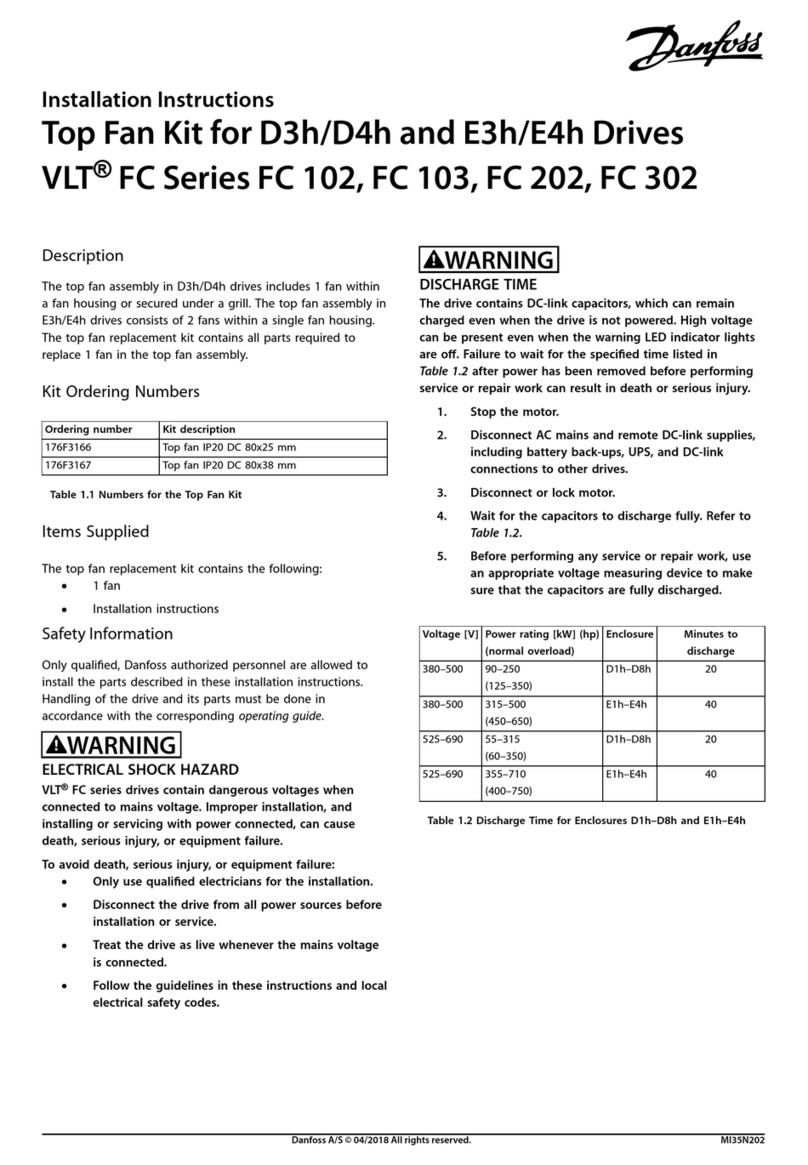
Danfoss
Danfoss 176F3166 installation instructions
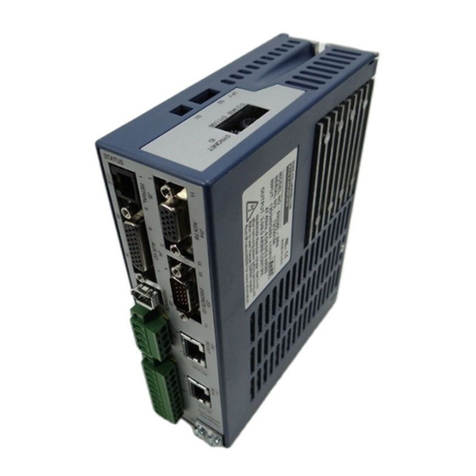
Kollmorgen
Kollmorgen S20260 installation guide
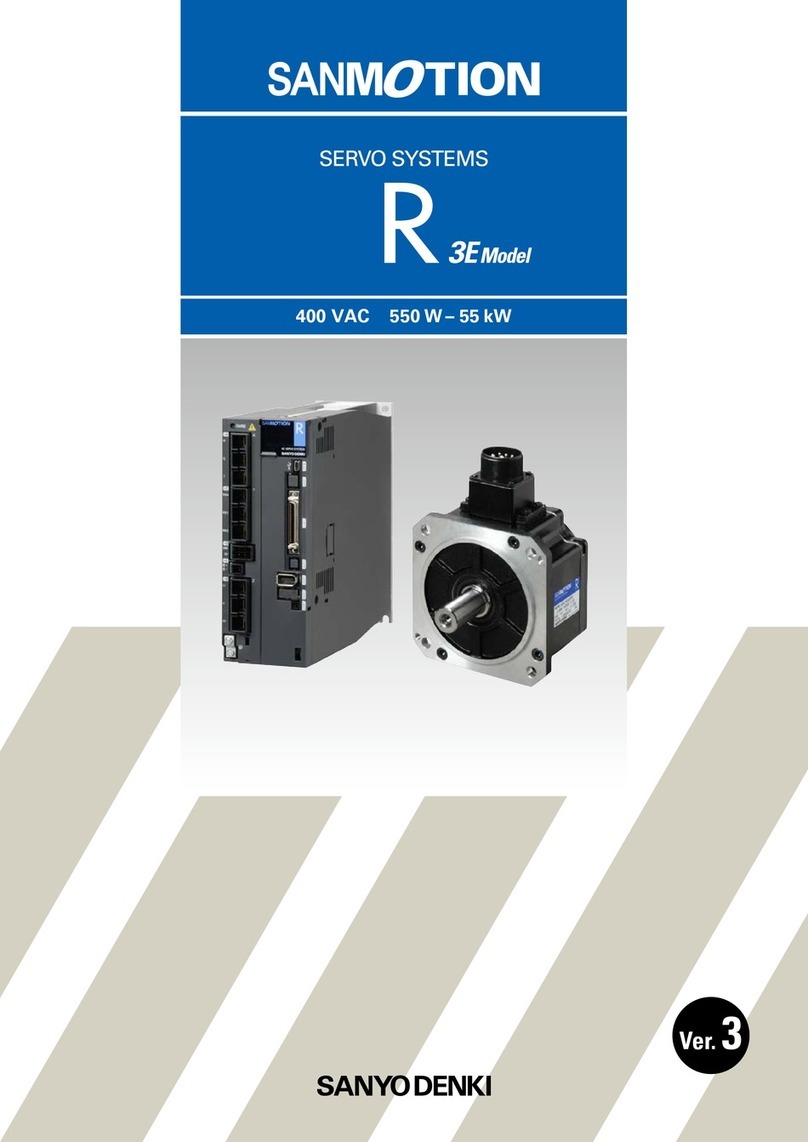
Sanyo Denki
Sanyo Denki SANMOTION R3E manual
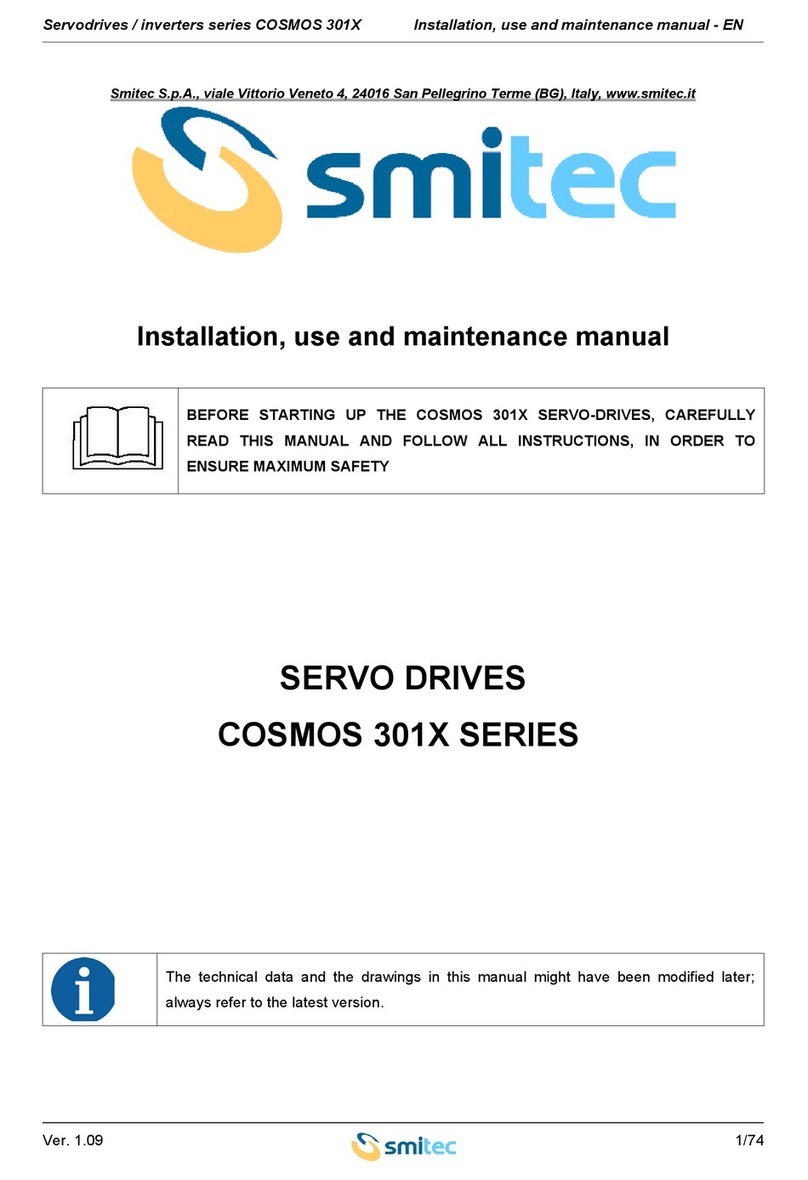
Smitec
Smitec COSMOS 301 Series Installation, use and maintenance manual
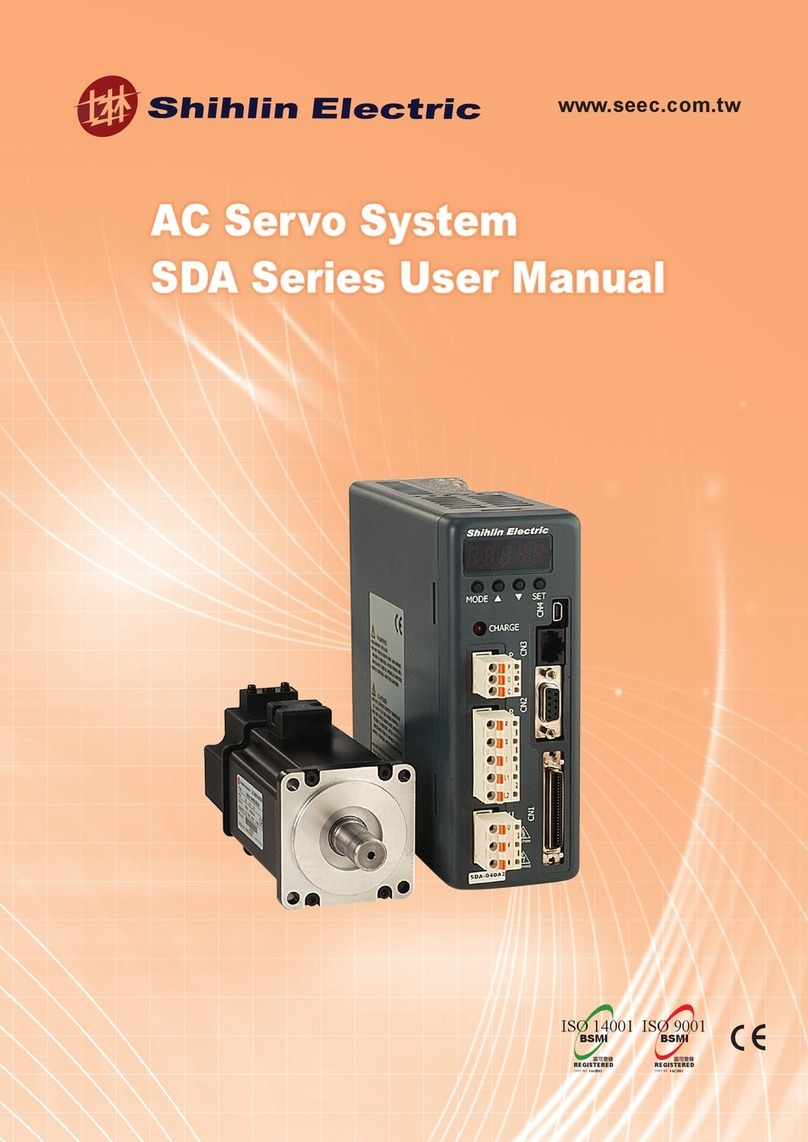
Shihlin electric
Shihlin electric SDA Series user manual

BLUM
BLUM Tandem installation instructions
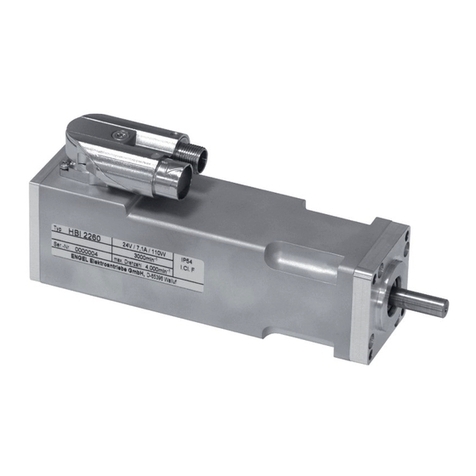
Engel
Engel HBI22 Series operating manual
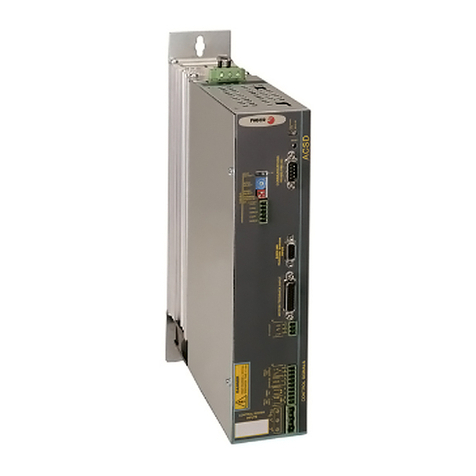
Fagor
Fagor ACSD series Original instructions
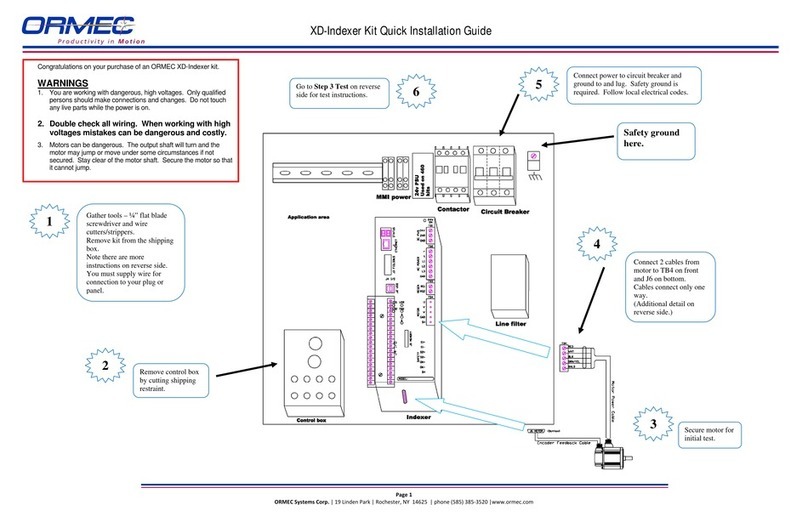
Ormec
Ormec XD-Indexer Kit Quick installation guide
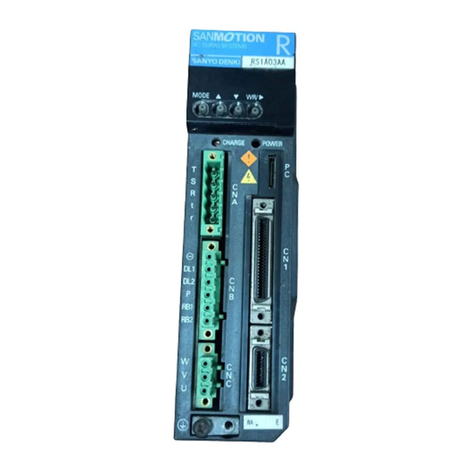
Sanyo Denki
Sanyo Denki Sanmotion R instruction manual
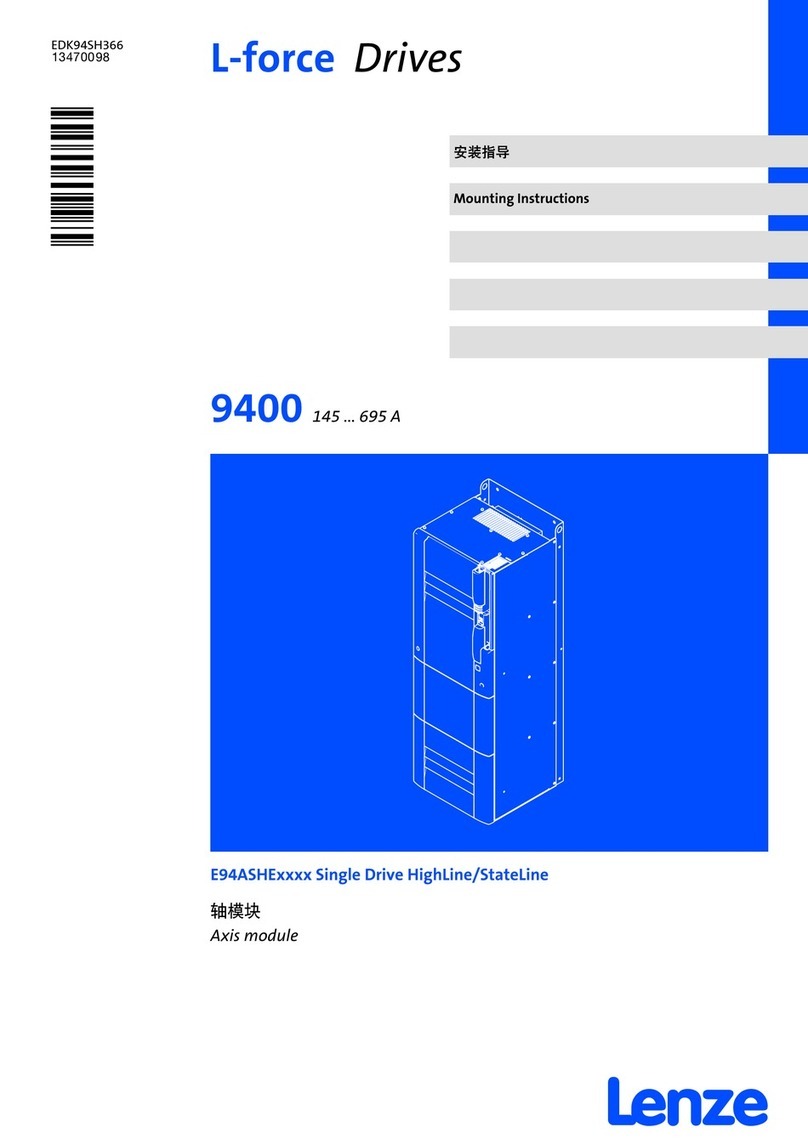
Lenze
Lenze L-force Drives 9400 Series Mounting instructions
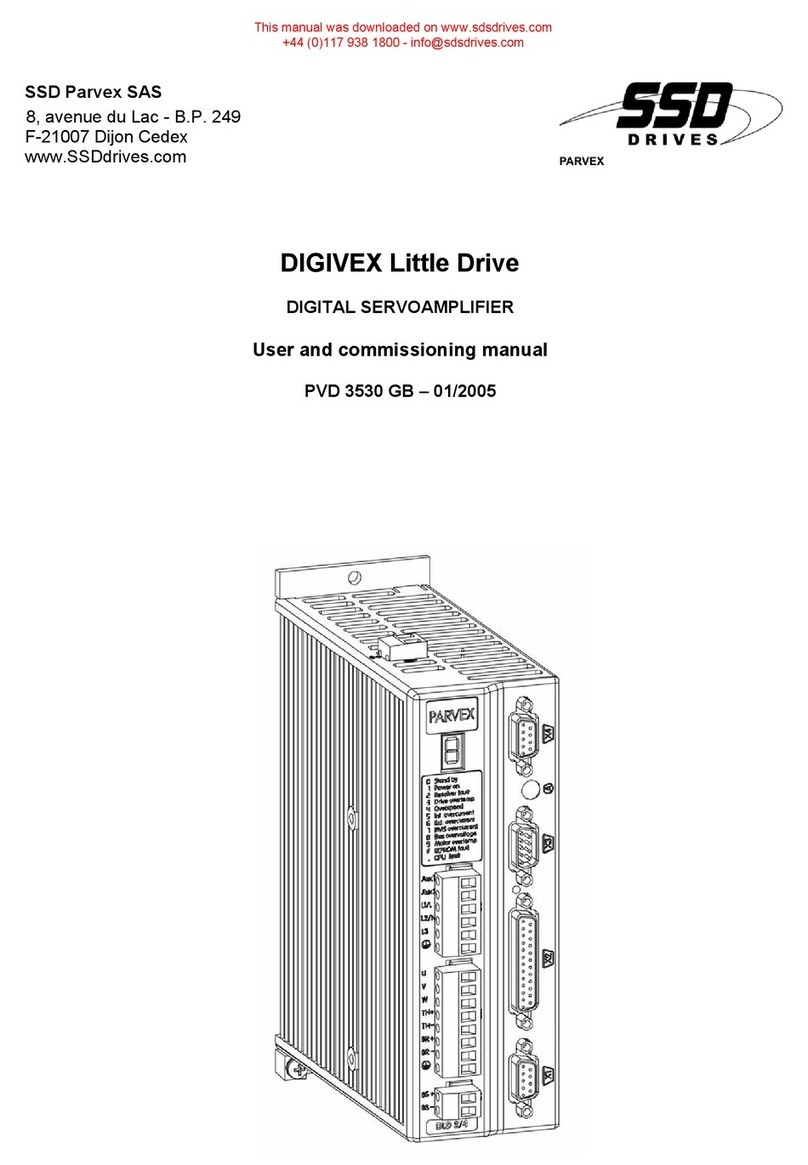
SSD Parvex
SSD Parvex DIGIVEX Little Drive Servoamplifier User and commissioning manual


